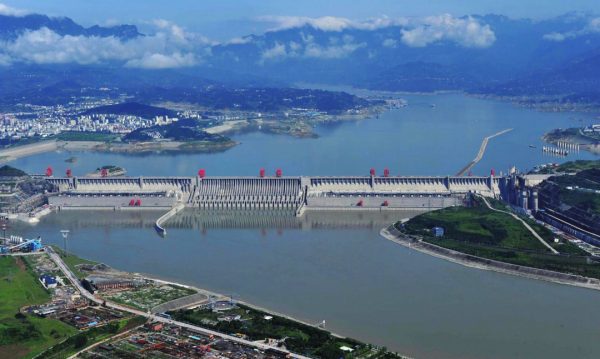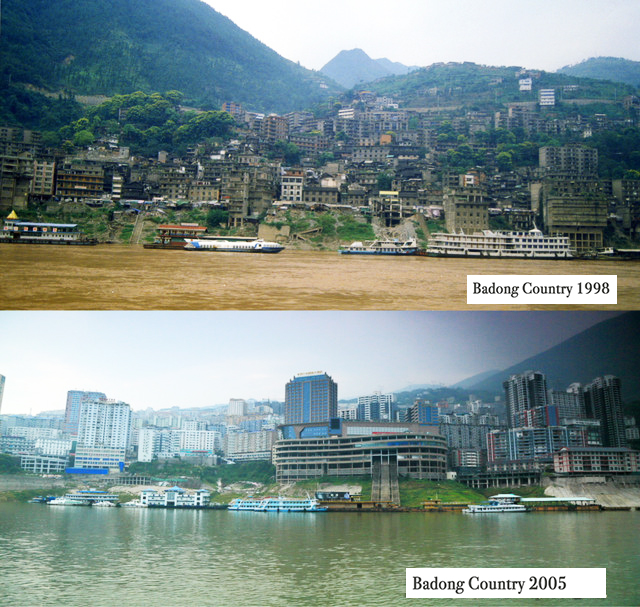
The Three Gorges Dam has been the subject of controversy in China ever since its conception. This colossal engineering project, which stretches across Xiling Gorge of the Three Gorges in Hubei province, is 2,335 metres (7,660 ft.) long, approximately 185 metres (607 ft.) high, and was constructed from 28 million cubic metres (37 million cu. yd.) of concrete and 463,000 metric tons of steel. To put that into perspective, that’s enough steel to build the Eiffel Tower 63 times over! Construction began in 1994 and, at the time of its completion in 2006, it was the largest dam in the world.
The idea for the dam was first discussed by Sun Yat-sen during the 1920s, but wasn’t seriously considered until Chairman Mao Zedong ordered detailed planning for the project in 1955. In fact, Chairman Mao was so enamoured with the idea of the dam that he wrote a poem dedicated to it, which he entitled “Swimming”. However, lack of funds and heavy criticism of the project meant that Chairman Mao was unable to achieve his dream. In short, he just couldn’t give a dam!
It wasn’t until 1992 that Premier Li Peng, who was himself trained as an engineer, was able to convince the National People’s Congress to ratify the decision to build the dam. Nearly one third of congress members either abstained or voted against the project, which represented an unprecedented level of resistance from a typically compliant government body. With so much opposition facing the project, it’s difficult to see exactly why anyone would want to build it in the first place.
The main impetus driving the construction of the dam was two-fold: to produce electricity and to help prevent flooding. The dam functions as a hydroelectric power-plant and is able to produce as much energy as 15 coal-burning power stations. This has reduced the need for coal mining in northern China, lessened pollution in the region, and provided nine provinces with clean energy. It has also created a deep-water reservoir, which allows oceangoing vessels to safely navigate a path from Shanghai on the eastern coast to the inland city of Chongqing. This means that freighters can now transport goods where trucks would otherwise have to be used, which has heavily lessened harmful fuel emissions.
It is estimated that every year the dam reduces air pollution by 100 million tonnes of greenhouse gas emissions, millions of tonnes of dust, one million tonnes of sulphur dioxide, 370,000 tonnes of nitric oxide, 10,000 tonnes of carbon monoxide, and a significant amount of mercury. If that wasn’t enough, the dam is also primarily designed to protect millions of people from periodic and devastating flooding that takes place annually on the banks of the Yangtze River. However, as with all large-scale projects, these benefits have come with a heavy price.
Upon its construction, the dam flooded over 500 cities, towns, and villages, which displaced approximately 1.3 million residents. Relocating all of these people consumed over 45% of the project’s budget alone! While some of them were moved to places within Hubei province and nearby Chongqing, others were sent much further afield to the provinces of Hunan, Sichuan, Jiangxi, Jiangsu, Zhejiang, Guangdong, and Fujian. The social impact of the dam has been immense, as local businesses were forced to close and many of the displaced are still struggling to recoup their losses while simultaneously adjusting to the local culture in their new homes.
Yet these social problems pale in comparison to the environmental damage that the dam continues to cause. It currently blocks the natural flow of sediment down the Yangtze River, which has resulted in sediment build-up above the dam and severe lack of sediment downstream. The absence of this sediment could potentially make downstream areas more vulnerable to flooding and weakens the bed on which Shanghai is built, while the build-up of sediment upstream is harmful to aquatic wildlife. Much of this sediment is created by erosion from rising water in the dam’s reservoir, which also frequently results in major landslides.

Over 6,300 species of plant once populated the area surrounding the dam, the majority of which were classed as endangered and were used as ingredients in traditional Chinese medicine. However, since the dam was built, the percentage of forested area in the region has dropped from 20% to 10%, which has had an enormous negative impact on the resident plant species. It has also changed the water temperature and flow of the Yangtze River, which has affected the 361 freshwater fish species that populate it. Numerous scientists believe that the dam was the direct cause of, or at least a major contributor to, the extinction of the baiji or Chinese river dolphin. Talk about a damming testimony!
As if the catastrophic environmental affects weren’t enough, the dam’s reservoir flooded over 1,300 archaeological sites, some of which could not be salvaged or moved. Historical treasures such as the hanging coffins of Shennong Gorge were tragically lost under the cascading waters. Although river cruises are now able to explore areas of the Three Gorges that were previously impenetrable, the dam itself has altered the appearance of this glorious natural site forever.
In 1997, the Three Gorges Dam Scenic Area was opened to the public and includes: the Exhibition Hall of the Three Gorges Project, where visitors can learn about the history and construction of the dam; Tanzi Ridge, the 185 Platform, and the Dam Viewing Point, which offer panoramic views of the dam and the surrounding countryside; and the Memorial Garden, a large open-air museum featuring machinery used to build the dam. While curious visitors flock to the dam in their thousands, debate rages on as to whether it should have ever been built in the first place.